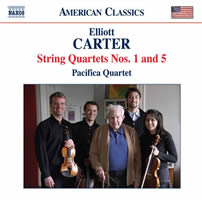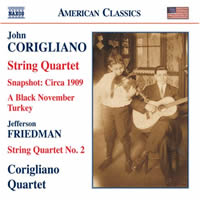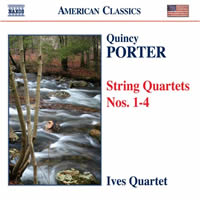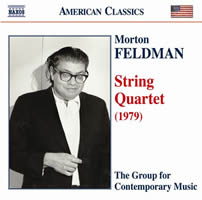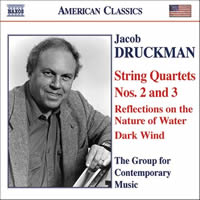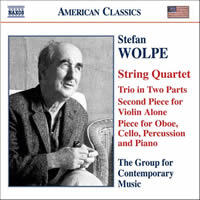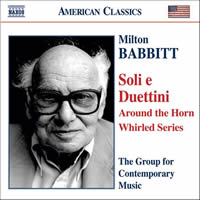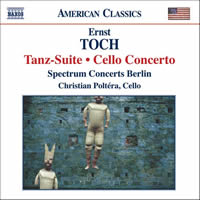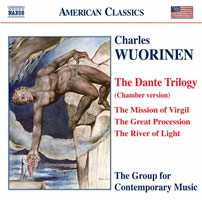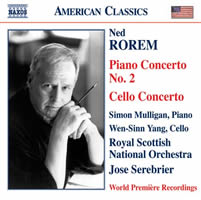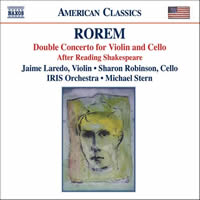Naxos Bowl 3: Some American Classics
|
Grant Chu Covell [April 2008.]
Elliott CARTER: String Quartet No. 1 (1951); String Quartet No. 5 (1994-95). Pacifica Quartet: Simin Ganatra, Sibbi Bernhardsson (vlns), Masumi Per Rostad (vla), Brandon Vamos (vlc). Naxos 8.559362 (http://www.naxos.com/). John CORIGLIANO: Snapshot: Circa 1909 (2003); A Black November Turkey (2003); String Quartet (1995). Jefferson FRIEDMAN: String Quartet No. 2 (1998). Corigliano Quartet: Michael Jinsoo Lim, Lina Bahn (vlns), Melia Watras (vla), Jeffrey Zeigler (vlc). Naxos 8.559180 (http://www.naxos.com/). Quincy PORTER: String Quartet No. 3 (1930); String Quartet No. 2 (1925); String Quartet No. 1 (1922-23); String Quartet No. 4 (1931). Ives Quartet: Bettina Mussemeli, Susan Freier (vlns), Jodi Levitz (vla), Stephen Harrison (vlc). Naxos 8.559305 (http://www.naxos.com/). Jennifer HIGDON: Piano Trio (2003); Voices (1993); Impressions (2003). Anne Akiko Meyers (vln), Alisa Weilerstein (vlc), Adam Neiman (pno); Nicholas Kitchen, Melissa Kleinbart (vlns), Hsin-Yun Huang (vla), Wilhelmina Smith (vlc); The Cypress String Quartet: Cecily Ward, Tom Stone (vlns), Ethan Filner (vla), Jennifer Kloetzel (vlc). Naxos 8.559298 (http://www.naxos.com/). It’s not just that I think of Carter’s First as the greatest American quartet of the 20th century: the Pacifica Quartet’s programming of all five makes clear Carter’s indelibility. Where the First was tightly wound, the Fifth emerges whimsical and distracted. Easily matching the Arditti’s premiere recording (Montaigne MO 782091), the Pacificas seem to delight in the Fifth’s halting momentum and casual recollection of the previous four. Where the Ardittis may have relished the difficulty and angularity, the Pacificas pull Carter’s quartets towards the romantic tradition, softening rough edges and ripening expressive opportunities. Grammy Award winner David Frost produced this finely recorded, firmly contoured playing from the Corigliano Quartet. Two smart vignettes, Snapshot: Circa 1909 and A Black November Turkey, precede the major offering. The former sparked by a boyhood photo of the composer’s uncle and father (eventually to occupy the NY Philharmonic concertmaster’s chair), the latter a coarse arrangement of a Richard Wilbur choral setting. In the 1995 String Quartet, five Bartók-flavored movements spin and shake through a variety of mostly somber moods. I’m more taken with the work today than when its dedicatees, the Cleveland Quartet, took it on the road. I felt cheated when the composer rearranged the piece for string orchestra and let the Boston Symphony Orchestra premiere it as his Second Symphony (2000). The materials, sometimes spatially notated or microtonal, work better on the small scale. Friedman (b. 1974), a former Corigliano student, fills side B with his 22-minute Second. The younger composer’s aggressive bluster contrasts distinctively with his elder’s elegance. The Corigliano Quartet acquits itself with definitive performances. The Ives Quartet provides fine performances of the first four of Porter’s nine quartets, neat three-movement packages each. Porter’s Second emulates Bartók’s barbarism and energy, whereas the others strike modest neoclassical poses. Generally speaking, Porter’s quartets are bold and resolute affairs, leaning towards tonality. Fairly abstract, as opposed to folksy, their craft suggests an American Ravel. In Higdon’s 1993 string quartet, Voices, the Hungarian master hovers over the first movement but vanishes from the rhapsodic Soft Enlacing, which reminds one of Adams’ Shaker Loops. The mellow two-part piano trio Impressions (Pale Yellow and Fiery Red) takes its cues from Impressionist painting. Chardonnay in hand, Pale Yellow unfolds like a modal white-note piece, whereas Fiery Red hammers relentlessly, though not exceptionally menacingly. The 2003 string quartet, Impressions, similarly transfers visual associations into music, with a warm, yes, impressionistic vocabulary.
Morton FELDMAN: String Quartet No. 1 (1979). The Group for Contemporary Music: Benjamin Hudson, Carol Zeavin (vlns), Lois Martin (vla), Joshua Gordon (vlc). Naxos 8.559190 (http://www.naxos.com/). Jacob DRUCKMAN: String Quartet No. 3 (1981); Reflections on the Nature of Water (1986); Dark Wind (1994); String Quartet No. 2 (1966). The Group for Contemporary Music: Benjamin Hudson, Carol Zeavin (vlns), Lois Martin (vla), Joshua Gordon (vlc), Daniel Druckman (marimba). Naxos 8.559260 (http://www.naxos.com/). Stefan WOLPE: String Quartet (1968-69); Second Piece for Violin Alone (1966); Trio in Two Parts for Flute, Cello and Piano (1964); Piece for Oboe, Cello, Percussion and Piano (1954). Curtis Macomber, Theodore Arm (vlns), Toby Appel (vla), Fred Sherry (vlc), Harvey Sollberger (fl. and cond.), Charles Wuorinen, Aleck Karis (pno), Stephen Taylor (ob). Naxos 8.559262 (http://www.naxos.com/). Roger SESSIONS: Quintet for Two Violins, Two Violas and Cello (1958). Canons (to the memory of Stravinsky) for string quartet (1971); Six Pieces for Cello (1966); String Quartet No. 1 in E minor (1938). The Group for Contemporary Music: Benjamin Hudson, Carol Zeavin (vlns), Lois Martin, Jenny Douglass (vlas), Joshua Gordon (vlc). Naxos 8.559261 (http://www.naxos.com/). Under the “American Classics” banner, Naxos has reissued a stack of Koch recordings, containing expert quartet performances featuring The Group for Contemporary Music. Among them, a 1994 taping of Feldman’s First might be a low-risk way for the timid to approach the “long piece.” As compared with the Second, this 78:35 predecessor feels downright hurried. I suppose we’ve all come a long way in our appreciation of Feldman since this 1993 premiere recording. Druckman’s ingenious Third alternates variations with march and scherzo material. You’ll wonder why you’ve never heard it before and why it isn’t standard rep. Naxos also offers the Second (1966), the brief violin / cello duet Dark Wind, and a suite for solo marimba, Reflections on the Nature of Water, ably dispatched by the composer’s son Daniel. Both Wolpe and Sessions were revered as teachers. Feldman ranked Wolpe’s String Quartet (1968-69) among the greats, and Naxos reissues the vigorous Koch recording. From the three-minute Second Piece for Violin Alone to the Piece for Oboe, Cello, Percussion and Piano, these atonal pieces with Classical sensibilities explode with energy and lean melodies. Compared with Wolpe, who fled Nazi Germany and readily assimilated non-European influences, Sessions hewed closer to Germanic models, plunging into lyric serialism in the mid-’50s. His viola quintet is a stern affair, somewhat top-heavy on this recording despite the added player. The two-minute memorial canons pass in a flash; the cello’s Six Pieces are potent miniatures. The First string quartet nobly prefigures the later style with thick expressive lines and flourishing counterpoint.
“Soli e Duettini.” Milton BABBITT: Around the Horn (1993); Whirled Series (1987); None But the Lonely Flute (1991); Homily (1987); Beaten Paths (1998); Play It Again, Sam (1989); Soli e Duettini (1989); Melismata (1982). The Group for Contemporary Music: William Purvis (hn), Marshall Taylor (a-sax), Charles Abramovic (pno), Rachel Rudich, Susan Palma-Nidel (fl), Peter Jarvis (snare drum), Thomas Kolor (mar), Lois Martin (vla), David Starobin (gtr), Curtis Macomber (vln). Naxos 8.559259 (http://www.naxos.com/). Ernst TOCH: Tanz-Suite for Flute, Clarinet, Violin, Viola, Double Bass and Percussion, Op. 30 (1923-24); Concerto for Cello and Chamber Orchestra, Op. 35 (1924-25). Christian Poltéra (vlc), Spectrum Concerts Berlin, Thomas Carroll (cond.). Naxos 8.559282 (http://www.naxos.com/). “Dante Trilogy.” Charles WUORINEN: The Mission of Virgil (1993); The Great Procession (1995); The River of Light (1996). The Group for Contemporary Music, Oliver Knussen (cond.). Naxos 8.559345 (http://www.naxos.com/). John HARBISON: Piano Trio No. 2 (2003); Gatsby Etudes (1999); The Violist’s Notebooks (2002); Ten Micro-Waltzes (2004); Cucuraccia and Fugue (2003); Cello Suite (1993); Trio (1968). Amelia Piano Trio: Anthea Kreston (vln), Jason Duckles (vlc), Rieko Aizaewa (pno); Steven Tenenbom, Ida Kavafian, Anthea Kreston, John Harbison (vlas). Naxos 8.559243 (http://www.naxos.com/). Perhaps owing to Babbitt’s formidable reputation, few know his humor, as these wryly titled solos and duets reveal. Certainly, crafting Homily, a lone snare drum work, presumes an absurdist bent. Folks who think Babbitt difficult can set aside the prickly pitch choices and focus on his assured sense of rhythm. The two-part Around the Horn for French horn sprints like a manic Till Eulenspiegel. The flute and guitar duet, Soli e Duettini offers engaging rhythmic stuttering. The engaged listener ought to be ready to confront the final item, Melismata, for solo violin, the longest and most obdurate. Written in Germany, Toch’s six-part dance suite crosses Weill (Violin Concerto) with Schoenberg (Serenade, Op. 24, and Suite, Op. 29). With its rhythmic assuredness suggesting Stravinsky’s Histoire du Soldat, this is a bygone era’s program music. A bit in the last dance, Tanz des Erwachens, suggests Siegfried Idyll. Despite its bulk, the voluptuous four-movement cello concerto displays a toy-store impishness. Suddenly Schoenberg’s Kol Nidre and concerto after Monn make more sense. However they enhance our picture of 1920s Europe, these fine recordings appear in the “American Classics” line because Toch fled Nazi Germany for America. I’ve seen more Wuorinen than I have heard. Years ago I had a bit part on the team that copied scores and parts for several large-scale compositions. Naxos 8.559345 contains the chamber version of one of these. Each part of The Dante Trilogy, ballet scores for the New York City Ballet, exists in an orchestral or smaller rendition. Wuorinen’s energetic music sizes equally well from the astonishingly grandiose two-piano The Mission of Virgil to the modest chamber configurations of The Great Procession and The River of Light. Virgil recalls Webern’s Schoenberg piano arrangements. Procession is distinctly American by way of Stravinsky. Naxos’ catalog offers other Wuorinen items, assembled from expired Koch releases. Naxos 8.559264 houses a half-dozen volatile trios in wildly varied combinations (three are horn trios). The 1985 trombone trio (trombone, mallet percussion and piano) produces unimagined colors. Blustery music for four fills Naxos 8.559321 with the 1994 Percussion Quartet and the 1975 Tashi and 1979 Fortune both scored for clarinet, violin, cello and piano. Naxos 8.559288 comprises slightly larger groups, the String Sextet (1989), Second String Quartet (1979), Divertimento for string quartet (1982) and Piano Quintet (1994). Harbison’s music made more sense to me once I placed him in the context of neo-Classicists like Martinu and Stravinsky. Usually a diminishing tactic for others, Harbison drifts with confidence towards other periods and styles. A viola-heavy disc offers contrasting chamber music from a modernist First piano trio plucked from the 1960s and an elusive Second reminding this listener of a distracted Ives perusing through incomplete pages, one of which appears in the piano strings in the final movement, Enigma. Solo piano works include three lightly melancholy Gatsby Etudes sashaying between ragtime and Berg and the somewhat nostalgic Ten Micro-Waltzes, musical thank-you notes to concert benefactors. At center are The Violist’s Notebooks, 12 solo etudes, direct and neatly played. The four-viola Cucuraccia and Fugue represents “a species of viola joke” capped with a fugue. I suspect the first movement’s title might give it away. Completed cadences and logical phrases suggest the Cello Suite is more serious.
Earl KIM: Violin Concerto (1979); Dialogues (1959); Cornet (1984). Cecylia Arzewski (vln), William Wolfram (pno), Robert Kim (narrator), RTÉ National Symphony Orchestra, Scott Yoo (cond.). Naxos 8.559226 (http://www.naxos.com/). Ned ROREM: Piano Concerto No. 2 (1951); Cello Concerto (2002). Simon Mulligan (pno), Wen-Sinn Yang (vlc), Royal Scottish National Orchestra, José Serebrier (cond.). Naxos 8.559315 (http://www.naxos.com/). Ned ROREM: Double Concerto for Violin, Cello and Orchestra (1998); After Reading Shakespeare (1981). Jaime Laredo (vln), Sharon Robinson (vlc), IRIS Orchestra, Michael Stern (cond.). Naxos 8.559316 (http://www.naxos.com/). Arzewski makes a good case for Kim’s beguiling Violin Concerto as a closeted masterpiece. In two parts with multiple sections, delicate orchestration permits the soloist to soar. The 1959, somewhat neo-classical Dialogues deserves comparison with the Carter and Schoenberg concertos and Stravinsky’s Mouvements. Growing gradually more dispiriting, the compact concertino passes quickly. A narrator (here the composer’s nephew) recites Rilke’s “The Lay of the Love and Death of Cornet Christoph Rilke” for Cornet, an evocative portrayal of love and war. (Rilke’s text must be popular: Dacapo 6.220532 offers Paul von Klenau’s romantic 71-minute 1918-19 setting and MD&G 610 1444 contains Frank Martin’s.) The RTÉ shines under Yoo’s direction. Under the spell of Rorem’s three symphonies, I’m content to explore his other orchestral efforts. While the easy-going tonality isn’t my cup of tea, I admire the form and skillful construction. The substantial 1951 Second piano concerto contains a distinctive American broadness contrary to contemporaneous work. The inevitable French influence surfaces in the central Quiet and Sad. Mulligan appears both tender and resolute. The cello concerto sequences eight distinctly titled moods. The double concerto also requires eight movements, the program’s near-obscurity revealing a broad sweep of development. The work’s center has to be its longest movement, the Conversation at Midnight. The cello-solo after Shakespeare receives Robinson’s impassioned advocacy.
Babbitt, Carter, Corigliano, Druckman, Feldman, Harbison, Higdon, J Friedman, Kim, Porter, Rorem, Sessions, Toch, Wolpe, Wuorinen
[More
Babbitt, Carter, Corigliano, Druckman, Feldman, Harbison, Higdon, J Friedman, Kim, Porter, Rorem, Sessions, Toch, Wolpe, Wuorinen]
[Previous Article:
Words Fail Me 7.]
[Next Article:
Beth Levin's Live(ly) Goldberg]
|
